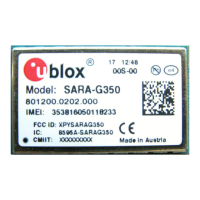SARA-G3 and SARA-U2 series - System Integration Manual
UBX-13000995 - R26 System description
Page 43 of 217
1.7 Antenna interface
1.7.1 Antenna RF interface (ANT)
The ANT pin of SARA-G3 and SARA-U2 series modules represents the RF input/output for 2G or 3G cellular RF
signals reception and transmission. The ANT pin has a nominal characteristic impedance of 50 and must be
connected to the antenna through a 50 transmission line for proper RF signals reception and transmission.
1.7.1.1 Antenna RF interface requirements
Table 9 summarizes the requirements for the antenna RF interface (ANT). See section 2.4.1 for suggestions to
properly design an antenna circuit compliant to these requirements.
The antenna circuit affects the RF compliance of the device integrating SARA-G3 and SARA-U2
series module with applicable required certification schemes. Compliance is guaranteed if the
antenna RF interface (ANT) requirements summarized in Table 9 are fulfilled.
50 nominal characteristic impedance
The nominal characteristic impedance of the antenna RF
connection must match the ANT pin 50 impedance.
See the SARA-G3 series Data Sheet [1] and the
SARA-U2 series Data Sheet [2]
The required frequency range of the antenna depends on
the operating bands supported by the cellular module.
S
11
< -10 dB (VSWR < 2:1) recommended
S
11
< -6 dB (VSWR < 3:1) acceptable
The Return loss or the S
11
, as the VSWR, refers to the
amount of reflected power, measuring how well the RF
antenna connection matches the 50 impedance.
The impedance of the antenna RF termination must match
as much as possible the 50 impedance of the ANT pin
over the operating frequency range, reducing as much as
possible the amount of reflected power.
> -1.5 dB ( > 70% ) recommended
> -3.0 dB ( > 50% ) acceptable
The radiation efficiency is the ratio of the radiated power
to the power delivered to antenna input: the efficiency is a
measure of how well an antenna receives or transmits.
The efficiency needs to be enough high over the operating
frequency range to comply with the Over-The-Air radiated
performance requirements, as Total Radiated Power and
Total Isotropic Sensitivity, specified by certification schemes
See section 4.2.2 for maximum gain limits
The power gain of an antenna is the radiation efficiency
multiplied by the directivity: the maximum gain describes
how much power is transmitted in the direction of peak
radiation to that of an isotropic source.
The maximum gain of the antenna connected to ANT pin
must not exceed the values stated in section 4.2.2 to
comply with regulatory agencies radiation exposure limits.
The antenna connected to ANT pin must support the
maximum power transmitted by the modules.
Application board with antenna detection circuit
If antenna detection is required by the custom application,
proper antenna detection circuit must be implemented on
the application board as described in section 2.4.2.
Antenna assembly with built-in diagnostic circuit
If antenna detection is required by the custom application,
the external antenna assembly must be provided with
proper diagnostic circuit as described in section 2.4.2.
Table 9: Summary of antenna RF interface (ANT) requirements
For the additional specific requirements applicable to the integration of SARA-G340 ATEX, SARA-G350
ATEX, SARA-U201 ATEX and SARA-U270 ATEX modules in applications intended for use in potentially
explosive atmospheres, see section 2.14.

